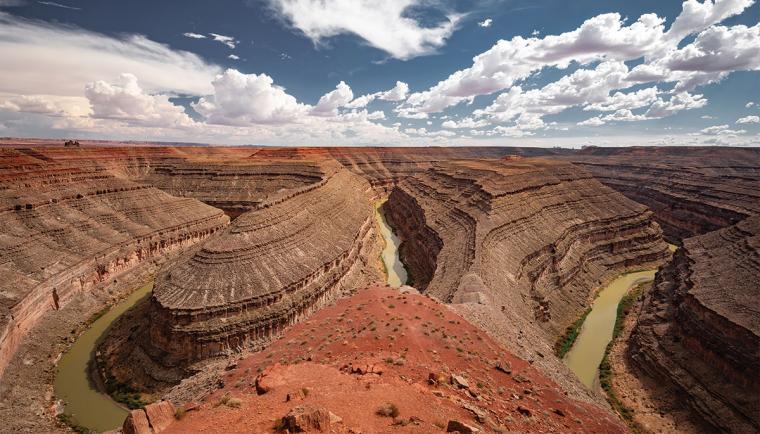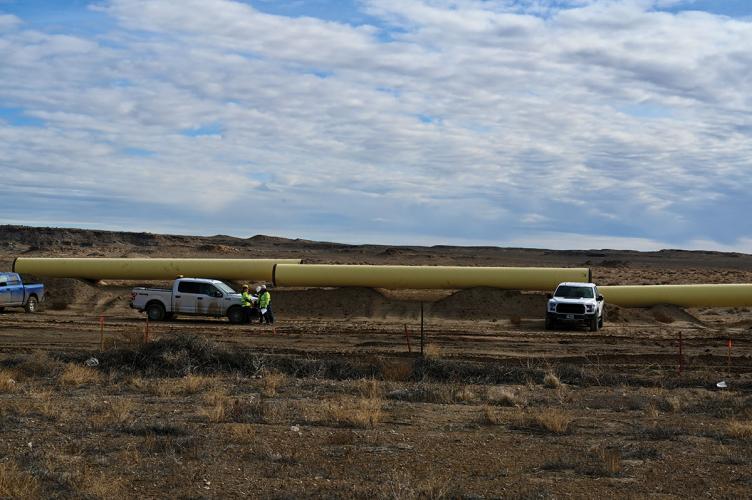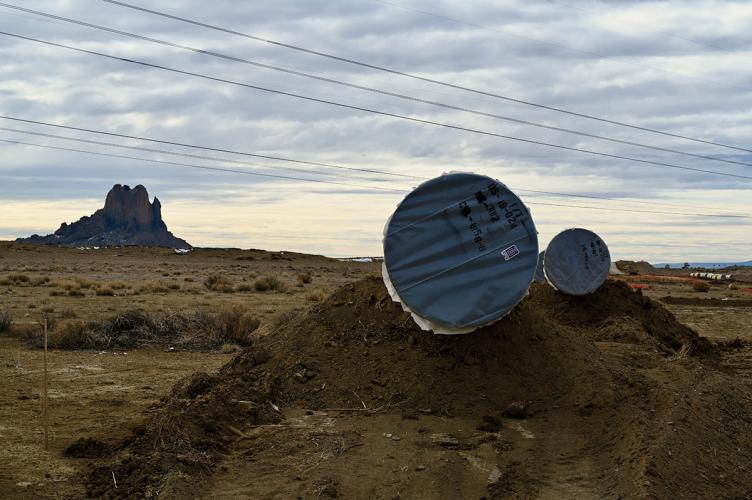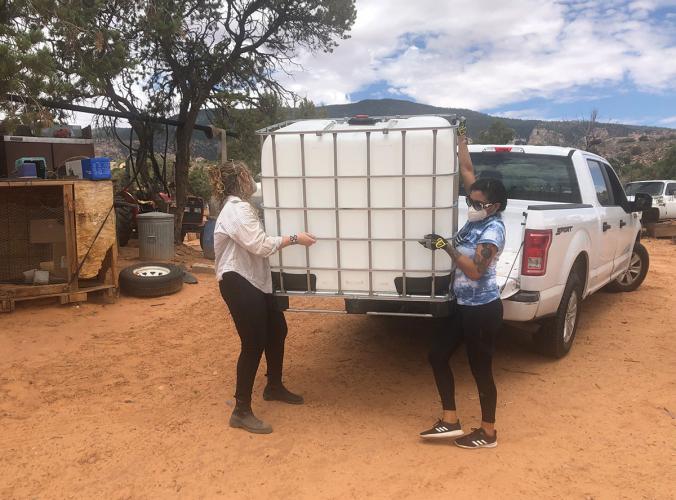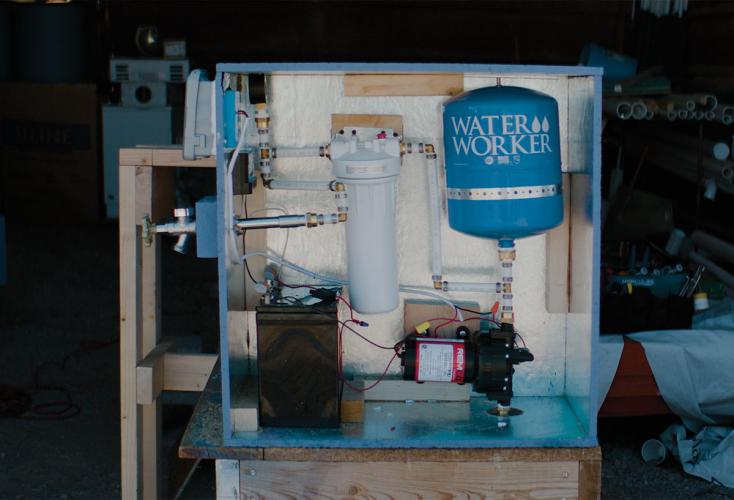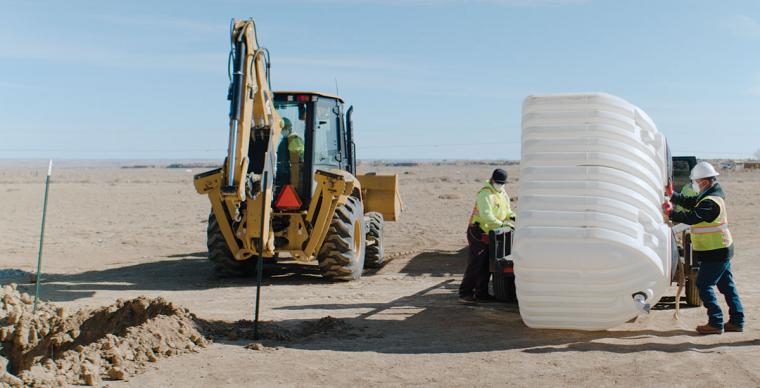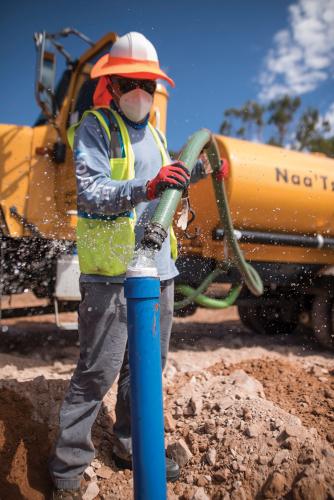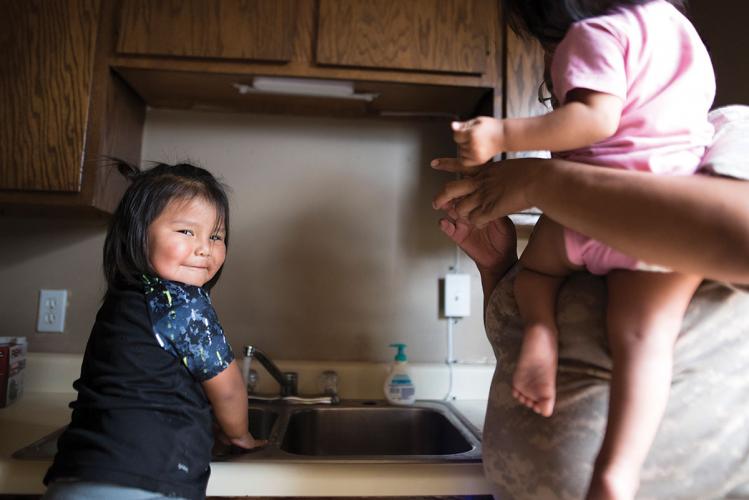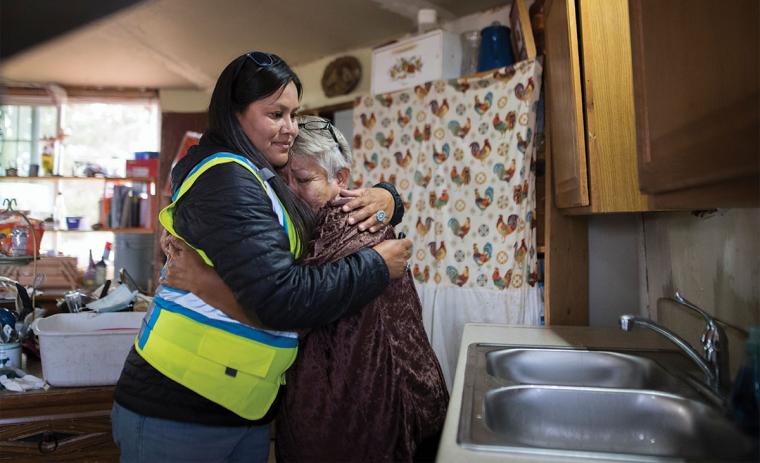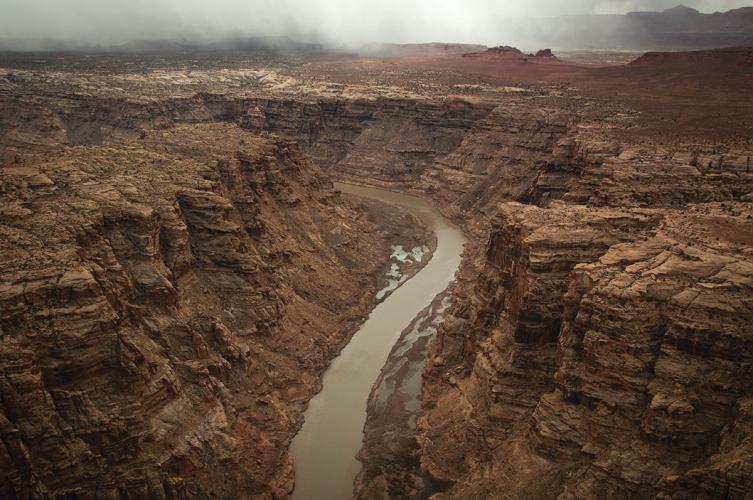During a nearly 100-mile, six-day journey down the San Juan River in southern Utah a couple of years ago, the raft in which I and a handful of others were riding shushed as it ran aground for the half-dozenth time. The oars of river guide Anabelle Yeston had been digging more into sand than water, so she hopped out, waded to the front of the raft and grabbed the bowline normally used to tether the craft to land and pulled it forward. Then the boat lurched to a stop again, and everyone on board had to step off into shin-deep water so the boat would float again. She headed toward the canyon wall, trying to weave among sandbars hidden beneath the wind-blown surface of the water. Where red sandstone loomed overhead and the river swung wide around the bend, the water deepened and we were able to climb back aboard and continue on our way.
The low water level here was a snapshot of what the entire watershed has been experiencing for decades. The Southwest is facing its worst drought in 1,200 years, cutting the flows of the region’s rivers. This gap could worsen water-supply and access problems for the region’s Native communities that began more than a century ago.
The San Juan River is a tributary of the Colorado River that begins in Colorado’s San Juan Mountains and joins the main stem in southern Utah. Its path runs along the north edge of the Navajo Nation, which spreads across 27,000 square miles over the corners of what is now Utah, Arizona and New Mexico. The Colorado River Compact—which seven states created in 1922 without input from the area’s Native peoples—dictates the upper basin states of Colorado, New Mexico, Utah and Wyoming and the lower basin states of Arizona, California and Nevada each receive 7.5 million acre feet per year. The Mexican Water Treaty of 1944 also commits 1.5 million acre-feet to Mexico annually.
The 16.5 million acre feet of water these laws allocate, however, exceeds the amount of water the Colorado River has held in recent decades. The combined forces of climate change– induced droughts and stagnant laws make for a brewing crisis for the river as well as the millions of people who depend on it for agriculture and everyday uses, including drinking water.
A Dry Promise
All of the San Juan River was once within Dinétah, the homeland of the Diné, or Navajo, people. The treaty between the Diné and the U.S. government that established the Navajo Nation in 1868 came with an implicit promise of water for people living on that reservation, though it took a 1908
U.S. Supreme Court decision, called the Winters Doctrine, to affirm that. Still, for tribes to quantify how much water they have a right to and gain access to that water has required lengthy negotiations with states and settlements the U.S. Congress then has to approve. Tedious legal proceedings have left more than 30 percent of homes on the Navajo Nation without running water. Many of the people living in the remotest parts of the reservation must drive hours to water pumping stations, where they will fill containers and haul them back home.
Thirty federally recognized tribes depend on the Colorado River or its tributaries, including the Chemehuevi, Cocopah, Fort Mojave, Fort Yuma Quechan, Hopi, Jicarilla Apache, Navajo, Southern Ute, Ute and Ute Mountain Ute. Some residents are concerned that by the time water reaches these communities, no water will be left for them. “For tribes who have water rights and they’re undeveloped at this point in time, the hydrology may not support the development of them in the future,” said Daryl Vigil (Jicarilla Apache/Jemez Pueblo/Zia Pueblo), former water administrator for the Jicarilla Apache Nation in northwestern New Mexico. Vigil also served as a spokesperson for the Ten Tribes Partnership, a coalition created to encourage officials to include Native nations in Colorado River water management. The partnership wrote in a 2018 report, “Even under the most favorable of circumstances for rapid tribal water development, the amount of water that will be used by the tribes is dramatically overshadowed by the effect of climatic conditions on the overall supply of water in the basin.”
The situation has Vigil asking whether it’s time to rethink the system entirely. “Yeah, there’s better engagement and better inclusion,” he said. “But we don’t need better. We need transformation.”
“When we were doing that water rights work with those traditional grassroots Hopi leaders and traditional grassroots Navajo leaders, they both came to the same conclusion: If we as peoples keep participating in this process where we’re divvying up every last drop of this river and claiming it as our own, we are just as culpable to the death of that river,” said Janene Yazzie (Diné), who co-founded Sixth World Solutions, an organization that pushes for sustainable development on tribal lands. “We don’t want that culpability,” she said. “We want this river to be maintained and protected in such a way that it sustains itself.”
Pipeline Problems
The U.S. Bureau of Reclamation has been tasked with studying potential water development projects since 1902. It first proposed the idea of a pipeline to bring water into the Navajo Nation in the 1950s. But it was not until the Navajo Nation and the state of New Mexico settled on the Navajo Nation’s water rights in the early 2000s that a real plan emerged for a pipeline that would run from near Farmington in northwestern New Mexico to Gallup, a Navajo Nation border town about 120 miles south. The pipe is part of a project that would draw 37,764 acre feet from the San Juan River each year, or about 50 cubic feet per second, to supply approximately 250,000 people on this reservation as well as to Gallup and the Jicarilla Apache Nation.
Yet the San Juan River is half the river it once was. A century ago, it roared at 4,000 cubic feet per second; during the last two decades, it topped out only around 1,500 cubic feet per second. The area it runs through, the Colorado River’s Upper Basin, already had nearly 20 percent less water during recent decades, at least half of which is attributed to climate change. “That almost 20 percent reduction is what’s creating this pinch,” said Brad Udall, water and climate researcher at the Colorado Water Institute.
That number averages the river’s trio of major branches: the Colorado River out of central Colorado, the Green River in western Wyoming and the San Juan, which is the farthest south and has been hardest hit by climate change and water development projects, said John (Jack) C. Schmidt, the Janet Quinney Lawson Chair in Colorado River Studies at Utah State University. Pair climate change with current water use and researchers foresee a future in which the river spends some coming years shrunken to a level that barely sustains the fish that live in it, the wildlife that rely on it and the plants that grow alongside it. A difference of 50 cubic feet per second likely isn’t palpable to anyone, Schmidt said, but it is the cumulative weight of these demands, each taking a little until there’s none left. As he said, “Rivers without water aren’t rivers.”
When water was divvied up, the states were expected to share some portion of their water with tribes within their boundaries. The framework puts tribes competing with states’ ambitions in a region where water access translates to economic opportunity and growth. Tribes were also left to negotiate with each state individually for how much water they were owed. The Navajo Nation has yet to reach an agreement with Arizona. However, it did settle with the state of Utah for 81,500 acre feet of water and $220 million for infrastructure projects in 2020 and with New Mexico in 2005, an agreement which Congress ratified in 2009. In that settlement, the nation agreed to take less water than the reservation’s size might have allowed and to be among the first to have to reduce water use if shortages arise. In exchange, it would receive funding for a pipeline to bring water closer to its communities. That Navajo-Gallup Water Supply Project is now underway, and the 280 miles of pipeline through more than 40 communities are expected to be completed by 2028.
But the project faces a string of hurdles, said Jason John, director of the Navajo Department of Water Resources. Among them, the federal funding of $995 million was based on rough designs. As construction costs increased, congressional funding didn’t. The projected funding gap has been estimated at more than $600 million. The nation might seek other funding, but the notion that the effort might be abandoned incomplete “probably keeps some people up at night,” John said.
Federal funding also did not include connecting communities to the project’s trunklines. Individual Navajo Nation chapters, often communities of just a few hundred people, are left to find the millions of dollars for those projects themselves. About $1.07 billion from the American Rescue Plan Act is going to new water lines on the nation as well as electric lines, broadband internet connections and housing projects. It’s a significant sum, and yet still not enough to address the need. Newly inaugurated Navajo Nation President Buu Nygren campaigned on improving infrastructure for tribal members, and his spokesperson said water access is top of mind.
Connecting More Homes
On the Navajo Nation, homes tuck into numerous small canyons, shielded from view by tawny mounds of sandstone, sheltered from the wind by fins of rock. Hogans—round, traditional structures—and trailers sprout from red earth, ringed by little but miles of blue sky. It’s possible the pipeline will come right by these scattered homes and never offer them water.
To the Indian Health Service, reaching these homes with water or powerlines often ranks as “economically infeasible.” That’s the case for more than half of the $2.3 billion in estimated costs the federal agency faces to add or fix failing water lines that serve Alaska Native and American Indian homes. Projects are deprioritized based on expense, which means repairs or maintenance are addressed ahead of the costly efforts to deliver water to the 38,000 homes the agency estimates are missing a safe water supply. According to a report by the U.S. Water Alliance and DigDeep, a nonprofit organization focused on connecting people in America with clean water, Native American households are 19 times more likely to lack indoor plumbing than white households, and that number jumps to 67 times more likely for Navajo Nation residents.
“The Indian Health Service has had to prioritize water projects across the Navajo Nation,” John said. The annual need tops $500 million, he said, “and their annual appropriation to tackle that list has been $20 million to $30 million a year.”
When the COVID-19 pandemic hit the Navajo Nation in early 2020, the absence of this basic service for some 37,000 people fueled the public health crisis. People could not readily wash their hands or stay home as they had to venture out to refill water containers.
In 2022, the Bipartisan Infrastructure Law awarded $2.5 billion to deliver long-awaited water to more than a dozen tribes across the nation in need of better water access, including the Navajo Nation. New Mexico’s congressional members announced in February of this year that $137 million of this funding would be allocated to the pipeline, and another $2 million for its operation, maintenance and replacement efforts.
In theory, John said, the funding means the Indian Health Service (IHS), which maintains a list of individual homes without basic sanitation services, will be able to connect more families with running water. “That’s a huge deal for the Navajo Nation,” John said, adding, there is a “very high likelihood” those projects will be built in the next seven years if they are on the current IHS list of 9,000 homes in the Navajo Nation without water.
Finding Faster, Localized Solutions
Emma Robbins (Diné) watched her grandparents spend a lifetime on a waiting list for water to reach their home in the western Navajo Nation town of Cameron. They were not far from a pipeline, but they were in their 80s by the time they had running water. Soon after, her grandmother died of stomach cancer and her grandfather decided to leave his home.
For seven years, Robbins served as executive director of DigDeep’s Navajo Water Project. This initiative circumvents the wait for massive pipelines and water settlements by installing water systems at homes. Staff bury a 1,200-gallon cistern, then pipe it through a water heater to an indoor sink. Families are trained to operate and maintain the system, and reassured that a Navajo Water Project truck will return to refill the cistern monthly. “It’s better to give someone a solution for ‘Here’s how you can live here now,’” Robbins said. “It’s our right to live where we want to live on the reservation.”
She joined DigDeep shortly after the first tank and water supply system was installed at a Diné home. As of the summer of 2023, that number had climbed to 600. When COVID-19 hit the Navajo Nation, the project pivoted to an even nimbler strategy: in addtion to installing the 1,200-gallon cisterns, to ensure social distancing and protect outdoor pipes, they also installed above-ground 275-gallon cisterns and 100 suitcase-sized water systems with water spigots outside in two years. Water from these “suitcases” is now piped into homes and converted to more permanent home water systems.
The pandemic also prompted the formation of the Navajo Safe Water Project, a working group that includes the Navajo Nation, Navajo Tribal Utility Authority, DigDeep and others. That collaborative installed 58 free, safe water access points on the Nation, decreasing the average round-trip distance to fetch water from 52 miles to 17 miles.
Janene Yazzie, co-founder of Sixth World Solutions and now southwest regional director for NDN Collective, said, “There’s a lot of families who just live in very remote areas that will never see this [pipeline] in their lifetime. Our focus was going to be on those houses and families that were never going to be beneficiaries of that type of infrastructure.”
She organized the first, community-led watershed protection projects, helping 35 Navajo Nation communities develop a plan for cumulative water needs for not just domestic uses but also agriculture and the environment—all with an eye on the changing climate. One of her goals was to revive the stewardship of springs that have long supplied water to the Navajo people. After amending erosion through replanting vegetation and renewing traditional ecological practices that capture seasonal rains, some springs began producing water again. Through 2021, she worked with Navajo communities far from water sources to set them up with rainwater catchment and storage systems that could supply them for up to two weeks, and Sixth World partnered with the University of Arizona to develop and redesign off-grid, solar-powered water filtration systems.
“Being in the arid Southwest and dealing with this megadrought in the midst of climate change, we really have to be smarter as a citizen base around how these decisions are made and advocate collectively for more holistic approaches and more sustainable approaches that prioritize water security for everyone and everything,” Yazzie said. “At the end of the day, we’re still having to grapple with all of these complexities and try to find a pathway forward that honors who we are and how we understand this precious and sacred element and what our responsibilities are.”
A Winding Path Forward
This past winter, heavy snow falls in western states that have since melted helped provide a brief respite for the Colorado River Basin but no cure. The federal government still required Colorado River states to cut back. In May, three states in the Lower Basin—California, Arizona and Nevada— agreed to conserve 3 million acre-feet of water during the next three years in exchange for the Biden administration compensating the states for three-quarters of the water savings. Funds from the Inflation Reduction Act would pay farmers, American Indian tribes, cities and other consumers who voluntarily cut back on their consumption. In June, the Bureau of Reclamation stated it would work with tribes and state agencies to develop new operating guidelines for Lake Powell and Lake Mead in the basin, two of the United States’s largest water reservoirs, in an effort to stabilize the drain on the Colorado River.
But the Navajo Nation’s efforts to access that river stalled again with a June 2023 U.S. Supreme Court ruling that denied any federal responsibility for assisting the tribes in quantifying water rights their treaties promised. As reported by the Native American Rights Fund, “While the Court agreed tribal nations indeed have water rights under the Winters Doctrine, the Court nevertheless concluded there was no obligation to take steps to secure, or even identify, the water needed for the reservation.” In his dissenting opinion, Justice Neil Gorsuch wrote that it amounted to telling a tribe that has sought over and over to secure that access to “Try again.”
On the raft trip on the San Juan, we floated into a river canyon with some curves so tight the river nearly folded back onto itself. Ravens and vultures tilted overhead and bighorn sheep trotted by. When we jumped off onto muddy banks marked only with the dinosaurlike prints of great blue heron, we churned the surface with footprints that might stay there until next spring’s snowmelt filled the river again. Above a stretch of sand striped with cottonwoods and willows was an Ancestral Puebloan dwelling built into the sandstone cliffs. White handprints spotted its back walls. The structures were built high enough to withstand a river that flooded all the way to the cliff face. The river we floated that day was one-hundredth the level the water might have reached then.
“We assume there’s plenty of water out there, we just need the infrastructure to bring it to us, and I think what would be important in this time is to recognize how unsustainable our demand has become,” Yazzie said. “We can’t just keep having solutions that are based on maintaining human consumption and use. We have to think deeper and with a deeper consciousness about our relationships to these vital, sacred, life-giving forces if we really are going to change this reality that we’re facing.”

